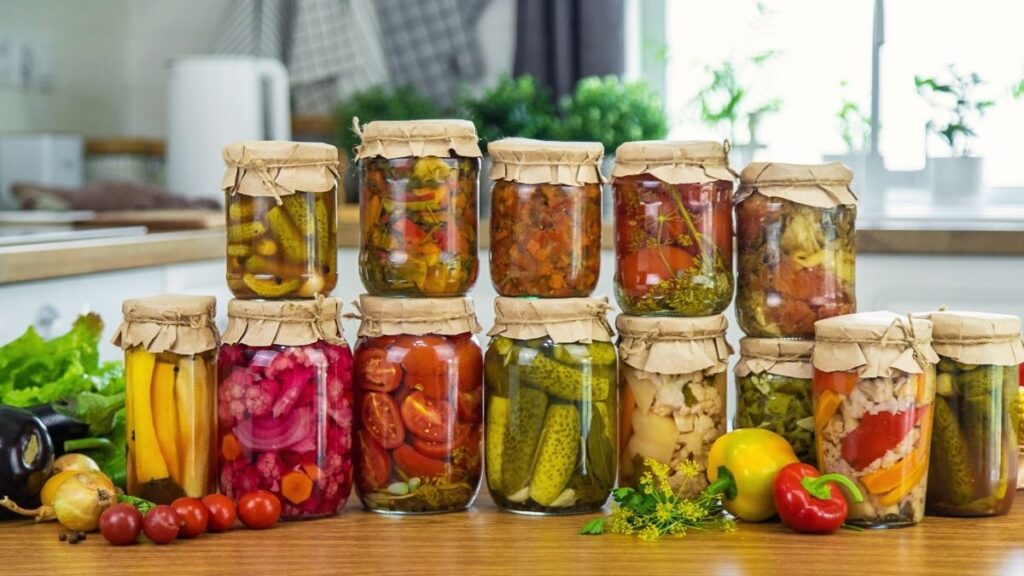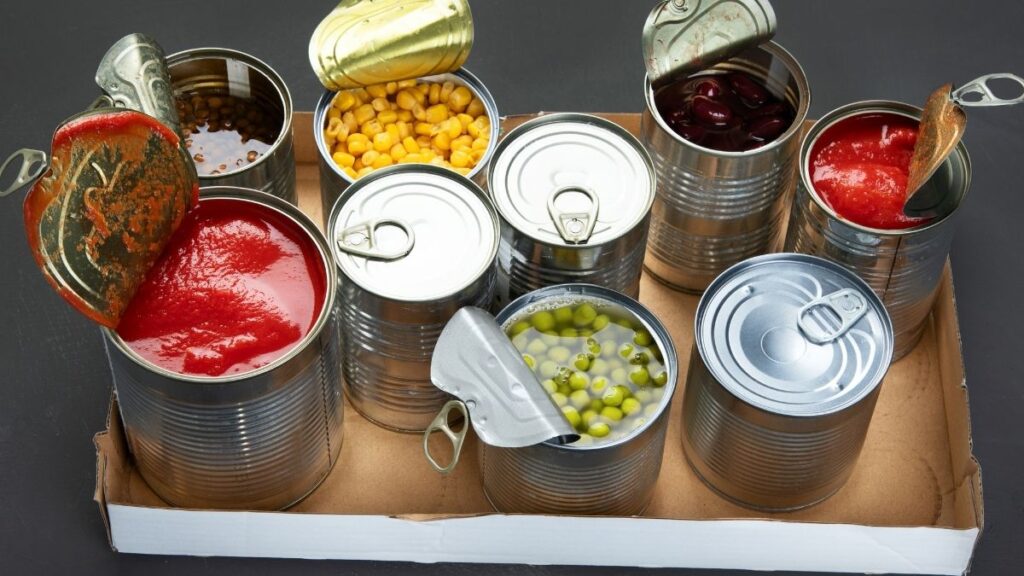Can Canned Veggies Save Your Diet? The Shocking Truth About Senior Nutrition (Hack That Could Save a Senior’s Diet)
For decades, the “fresh is best” mantra has dominated nutrition, but for older adults in 2025, that isn’t the complete story. The daily challenge is real: you need more protein, fiber, and specific vitamins, but you’re juggling a fixed budget, less energy for cooking, and fresh produce that spoils.
The canned food aisle is affordable and convenient, but it’s also a source of fear. This article reveals the “shocking truth” about canned veggies: the dangers like high sodium are real , but they are almost entirely manageable.
This is your 2025 guide to using canned veggies to save your senior nutrition plan by learning the facts, risks, and simple, actionable steps to make them a smart choice.
How to Read the “Code” on a Canned Food Label
A simple, color-coded shopping guide for better choices.
Serving Size 1/2 cup (120g)
Calories 100
Sodium 600mg
Total Sugars 12g
*Always check the label!
“No Salt Added”
This is your **#1 choice**! These products only contain natural sodium, significantly reducing your intake.
Source: 1
“Low Sodium”
A great choice! Legally, this means the product contains **140 mg or less of sodium per serving**.
Source: 2
“Reduced Sodium”
**Avoid this marketing trap!** It only means 25% less sodium than the original product, which was likely very high. The sodium content is probably still too high for a healthy diet.
Source: 1
No Sodium Claim
This is a **red flag!** If there’s no claim, assume it’s high sodium. A single serving of some soups can have over 1,000 mg of sodium.
Source: 3
Your 3-Point Safety Check
- 🧂 Sodium: Always look for the “Green” labels (“No Salt Added” or “Low Sodium”).
- 🍬 Sugar: For canned fruit, the label must say “Packed in 100% Juice” or “in Water”.
- 🛡️ Safety: Look for the “BPA-Free” emblem on the can.
The Senior Nutrition Challenge: Why Senior Needs Are Unique in 2025

As the body ages, its nutritional needs shift, creating a significant challenge for older adults. This challenge is a paradox: even as caloric needs may decrease due to lower activity levels and changes in metabolism, the body’s requirement for certain key nutrients increases substantially.
This dynamic demands a focus on nutrient density, meaning every food choice must deliver a higher concentration of vitamins and minerals to maintain health.
Meeting these increased needs is a high-stakes issue. Specific 2025 nutritional guidelines for older adults highlight several critical areas of concern:
Protein: The Recommended Dietary Allowance (RDA) of $0.8 grams per kilogram (g/kg) of body weight is now considered insufficient for older adults. Emerging evidence and expert consensus recommend an increased intake of $1.0 to 1.2 g/kg per day.
This increase is a primary strategy to combat sarcopenia, the age-related loss of muscle mass and strength, which is a major predictor of frailty, falls, and a loss of independence. For a 150-pound (68kg) person, this updated guideline translates to 68-82 grams of protein daily, far more than many seniors consume.

Fiber: This nutrient is crucial for maintaining digestive health and is a key tool in managing risks for heart disease and diabetes. Per the National Academy of Medicine, the daily goal for adults 51 and older is 30 grams for men and 21 grams for women.
Key Micronutrients: Requirements for specific vitamins and minerals rise significantly.
Calcium: The need increases to $1,200 mg per day for women 51 and older and for men 71 and older, up from $1,000 mg for younger adults, to protect bone density.
Vitamin D: Essential for absorbing calcium, the recommendation is $600 IU for adults 51-70 and $800 IU for adults over 70.
Vitamin B12: While the daily goal is $2.4 mcg, the primary challenge is absorption. Many older adults have difficulty absorbing the B12 found naturally in foods, making fortified foods and supplements a critical part of their strategy.
Magnesium: For muscle and nerve function, men 51+ need $420 mg and women 51+ need $320 mg.
Potassium: This mineral is vital for cell function and blood pressure management. Men 51+ need $3,400 mg and women 51+ need $2,600 mg.
This nutritional landscape sets up a difficult conflict. Older adults need more potassium to help manage cell function, but less sodium to manage blood pressure. This challenge is amplified by common real-world barriers.
Many seniors live on fixed incomes, making budget constraints a primary concern. In 2025, an estimated 12.6 million Americans ages 50 and older face food insecurity, meaning their access to nutritious food is limited or uncertain.
Furthermore, the physical and mental energy required for complex meal preparation can be a significant hurdle, making convenience and shelf-stability a necessity, not a luxury.
2025 Myth-Busting: Are Canned Veggies Really Nutritious?

A common myth persists that canned food is “dead food,” void of nutritional value. This belief often forces seniors to choose between “fresh” produce they may not be able to afford or easily prepare, and a convenient option they fear is unhealthy. The facts, however, are more nuanced.
Produce destined for canning is typically picked at peak ripeness and processed within hours, a practice that “locks in” many nutrients. In contrast, “fresh” produce in a supermarket may have traveled for days or weeks.
During this transport and subsequent storage in a refrigerator, “fresh” produce steadily loses nutrients. Studies have shown that some produce, like green peas, can lose up to half of its Vitamin C within the first 48 hours of being harvested.
A week-old “fresh” green bean may, in fact, be less nutritious than its canned or frozen counterpart.
This is not to say the canning process is perfect. It creates a nutrient trade-off.
The Loss: The high heat required for canning does degrade some heat-sensitive, water-soluble vitamins, specifically Vitamin C and B-vitamins like thiamin and riboflavin. These losses are an unavoidable consequence of the heat sterilization process.
The Gain: That same heating process makes other powerful nutrients more available to the body, a concept known as bioavailability.
The most-studied example is lycopene, the potent antioxidant in tomatoes linked to heart health. The heat from canning breaks down the tomato’s tough cell walls, making the lycopene inside far easier for the body to absorb. Canned tomatoes consistently show higher levels of available lycopene than fresh ones.
Fat-soluble vitamins (like A, D, E, and K) and, importantly, minerals and fiber, are generally very stable during the canning process.
A second common myth is that canned foods are “full of preservatives.” In reality, the canning process is the preservative. The food is sealed in an airtight can and then heated, a process that kills harmful bacteria.
This creates a sterile, vacuum-sealed environment where chemical preservatives are not necessary for simple vegetables.
The Academy of Nutrition and Dietetics (AND) provides a useful distinction, classifying foods like canned tomatoes, canned tuna, and frozen vegetables as “foods processed at their peak to lock in nutritional quality”.
This category is distinct from “ultra-processed” foods like sodas, chips, and frozen dinners, which are industrial formulations high in added fats, sugars, and sodium.
The REAL Dangers: A Senior’s Guide to Canned Food Risks (2025 Update)
While the myths are largely false, the suspicions about canned goods are not entirely wrong. The risks are real, but they are known, visible, and, most importantly, solvable.
Danger #1: The Sodium Crisis

This is the primary and most significant danger in the canned food aisle for older adults. High sodium intake is directly linked to high blood pressure (hypertension).
For seniors, hypertension is not a minor issue; it is a major risk factor for heart attack, stroke, kidney disease, and cognitive decline.
While some research debates the direct link between salt and cognition, hypertension itself is a major, proven risk factor for cognitive impairment.
The problem is the massive gap between this ideal and reality. The average American consumes over 3,300 mg daily.
Over 70% of this sodium comes from packaged, prepared, and restaurant foods—and standard canned goods are a major contributor.
A single serving of a common canned soup can contain over 1,000 mg of sodium, or more than two-thirds of the ideal daily limit in one bowl.
Danger #2: BPA (Bisphenol A) 2025 Status

BPA is an industrial chemical historically used to make the epoxy linings of food cans. It is a known endocrine disruptor, meaning it can interfere with the body’s hormones, which has led to widespread health concerns.
The 2025 status of BPA is nuanced. The U.S. Food and Drug Administration’s (FDA) official stance is that BPA is “safe at the current levels occurring in foods”.
However, this position is heavily debated. New leadership at the Department of Health and Human Services (HHS) has pushed for new reviews of food-contact chemicals.
The actionable truth is that consumer pressure has largely minimized this risk. The market for “BPA-Free” cans and linings has exploded. As of 2025, it is estimated that up to 95% of food cans are now “BPA-Free”.
The danger is no longer a hidden, unavoidable chemical, but rather a simple failure to read the label. The solution is to look for the “BPA-Free” emblem.
Danger #3: Added Sugar & Dented Cans

Two other risks are easier to spot and solve.
Added Sugar: Fruits canned in “heavy syrup” or “light syrup” are high in added sugar. These empty calories contribute to health risks like type 2 diabetes, heart disease, and liver disease. The simple solution is to purchase fruit canned only in “100% juice” or “in water”.
Damaged Cans: A very rare but deadly risk is botulism, a toxin produced by the bacteria Clostridium botulinum. This can grow in a can that has been improperly sealed or compromised. A strict rule must be followed: NEVER use food from a can that is deeply dented (especially on a seam), bulging, cracked, or leaking.
The Canned Food “Code”: How to Shop Smart at the Grocery Store

The first and most effective solution to mitigating 100% of the sugar risk and most of the sodium risk is to master the Nutrition Facts label. The #1 rule is to read the label on the back, not the marketing claims on the front.
The “sodium showdown” is the most critical part of this lesson. Consumers must understand what the labels truly mean per FDA regulations.
The most common trap is the “Reduced Sodium” label. This label is highly misleading. It does not mean the food is low in sodium. It only means the product has 25% less sodium than the original version.
This is a relative claim, not an absolute health claim. If the original can of soup had a dangerous $1,000 mg of sodium, the “reduced” version still has $750 mg half the ideal daily limit in one serving.
This definitive shopping guide translates the FDA’s legal definitions into a simple “Buy/Avoid” format.
The 2025 Senior’s Guide to Canned Food Labels
The 2025 Senior’s Guide to Canned Food Labels
A simple “traffic light” guide to making healthy choices.
“Sodium-Free”
Fewer than 5 mg per serving.
Buy! The best possible choice.
“Low Sodium”
140 mg or less per serving.
Buy! A strong, healthy choice.
“No Salt Added”
No salt added during processing.
Buy! Only has natural sodium.
“Reduced Sodium”
25% less sodium than the original.
Avoid! This is a marketing trap. The sodium is likely still very high.
(No sodium claim)
Can be 480 mg, 1,000 mg, or much higher.
Danger! Only buy if no other option exists, and you commit to rinsing.
Senior-Smart Pantry List
- Canned Vegetables: Look for “No Salt Added” or “Low Sodium”.
- Canned Fruit: The label must say “canned in 100% juice” or “in water”.
- Can Linings: Look for the “BPA-Free” emblem on the label.
A “best-in-class” shopping list for a senior-smart pantry is straightforward:
- Canned Vegetables: Look for “No Salt Added” or “Low Sodium”.
- Canned Fruit: The label must say “canned in 100% juice” or “in water”.
- Can Linings: Look for the “BPA-Free” emblem on the label.
The 41% Solution: How to Prep Canned Veggies for Max Health

Shopping smart is the first line of defense, but what about seniors on a fixed income or those relying on a food pantry who cannot choose the “No Salt Added” option? There is a second, equally powerful action that gives control back to the consumer.
The single most important action is to drain and rinse.
The data is clear. For canned beans (like chickpeas, kidney beans, and black beans), draining them, rinsing them under lukewarm water for 10 seconds, and letting them drain for two minutes can reduce the sodium content by up to 41%.
For other canned vegetables, like corn and green beans, the effect is less but still significant. Draining and rinsing can reduce the sodium content by 9-23%. One study also found that for green beans, draining the canning liquid and then heating the beans in fresh water lowered the salt content by 33%.
This practice raises a logical question: “Does rinsing wash away the good nutrients?”
The honest answer is: yes, a small amount. The canning liquid does contain some water-soluble nutrients, like B-vitamins and folate, that have leached out of the vegetable. Rinsing washes these away.
However, the expert verdict is clear: The massive, immediate health benefit of removing 41% of a heart-damaging substance (sodium) far outweighs the minor loss of a few water-soluble vitamins, which can be easily replenished from other foods.
There are still plenty of nutrients, including fiber, left in the beans after rinsing. For anyone managing blood pressure, this trade-off is 100% worth making.
The Senior-Smart Pantry: 5-Minute Meals Using Canned Goods
This is the proof of concept, where all the advice comes together. These simple, no-cook or low-cook meals use canned goods to directly solve the 2025 senior nutritional challenges.
Meal 1: The Protein-Fiber Power Bowl

Ingredients: 1 can (rinsed) chickpeas, 1 can tuna or salmon in water.
Prep: Drain and rinse the chickpeas. Drain and flake the fish. Mix both in a bowl with 1 tsp olive oil and a squeeze of lemon juice. Serve over a handful of fresh spinach.
Why it Works: This zero-cook meal hits the two biggest senior goals. It provides a massive 30-40g of protein (to fight sarcopenia) and 10-15g of fiber (for heart health).
Meal 2: The 3-Minute Heart-Healthy Chili Base

Ingredients: 1 can (rinsed) kidney beans, 1 can (“No Salt Added”) diced tomatoes.
Prep: Combine both cans in a pot with 1 tsp chili powder and 1/2 tsp cumin. Heat and serve.
Why it Works: This is the ultimate “low-energy” meal. It is high in fiber, packed with heart-healthy lycopene from the cooked tomatoes, and loaded with potassium (from the tomatoes) to help the body manage blood pressure.
Meal 3: Quick Salmon Cakes (The Calcium Superstars)

Ingredients: 1 can bone-in salmon, 1 egg, 1/4 cup dry oatmeal.
Prep: Drain the salmon. Do not remove the soft, edible bones. Mash all ingredients together with a fork, form into patties, and pan-fry for 2-3 minutes per side.
Why it Works: This meal is a secret weapon. It is high in quality protein and, most critically, provides a large, non-dairy dose of calcium because the soft bones are mashed into the patty. This is one of the easiest and most affordable ways to help meet the high 1,200 mg calcium goal.
Other “senior-smart” staples to stock include canned pumpkin (for fiber and Vitamin A), canned artichoke hearts (in water), and canned peaches (in 100% juice).
Conclusion: The 2025 Senior Pantry, Reimagined
The 41% Solution
Slash Your Sodium by 41% in 10 Seconds!
Click a step above to see the details!
DRAIN (Step 1)
Pour the entire can into a strainer to remove all the salty canning liquid.
RINSE (Step 2)
Run lukewarm water over the beans for 10 seconds.
DRAIN (Step 3)
Let the water drain for 2 minutes to ensure all excess liquid is removed.
This simple process removes up to 41% of the sodium from canned beans! (Also works on veggies, reducing sodium by 9-23%).
You lose a tiny amount, but the massive benefit of removing 41% of heart-damaging sodium is a trade-off that is 100% worth it.
Canned vegetables are not the enemy of a senior nutrition plan; unmanaged sodium is.
The “shocking truth” is that the primary risks associated with the canned food aisle—sodium, BPA, and added sugar—are not only known but are almost completely solvable.
By following a simple, three-step code, older adults can eliminate these dangers:
Choose “No Salt Added” or “Low Sodium” options.
Look for the “BPA-Free” emblem on the label.
If “No Salt Added” options are not available, always drain and rinse beans and vegetables to significantly reduce sodium.
Canned foods can and should be used as a convenient , affordable , and highly nutritious tool to help older adults meet their unique and critical nutritional goals in 2025.








